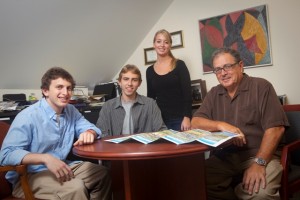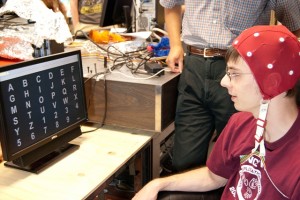
Ross Tilchin ’11 (left-right), Tyler Bamford ’12, and Hannah Finegold ’11 worked with Donald L. Miller, MacCracken Professor of History, on his forthcoming book about New York City.
The research Tyler Bamford ’12 (Souderton, Pa.) performed through the EXCEL Scholars program has helped him get closer to his goal of one day becoming a college professor. Bamford has received the prestigious Beinecke Scholarship, which will provide him with $34,000 toward graduate school in the arts, humanities, or social sciences.
As an EXCEL Scholar, Bamford worked with Donald L. Miller, MacCracken Professor of History, assisting with research and editing for Miller’s forthcoming book about New York City in 1927. He also helped Miller research a new HBO WWII documentary, He Has Seen War.
“I chose Lafayette specifically because of the strong history department, and also because the relationships I’ve built with the professors here would not have been possible to such a degree at a larger school. My professors pushed me to achieve a level of academic success that will serve me well in graduate school,” says Bamford, a history major.
The EXCEL program allows students in virtually any major to earn a stipend while working one-on-one or in small groups with faculty who are substantial contributors in their respective fields.
“Undergraduate research is an integral part of this community,” says John Meier, director of research services. “It is a natural outgrowth of having excellent students on campus who interact on a daily basis with faculty who are producing very interesting scholarly work. This sort of student-faculty interaction isn’t just valued; it is a deeply embedded part of our identity.”

Danielle Sobol ’12 takes water samples from Raritan Bay in New Jersey.
Approximately 140 students each summer and over 100 students each academic year take part in EXCEL, which allows them to work out in the field locally and globally.
Danielle Sobol ’12 (Wall Township, N.J.), who has a self-designed major combining art and biology, and Carolyn Cabrey ’12 (North Wales, Pa.), a biology major, worked with Megan Rothenberger, assistant professor of biology, to conduct chemical and biological analyses of water samples taken from Raritan Bay in New Jersey. Their work will contribute data toward a long-term Raritan Bay monitoring project assessing how water quality has changed over time.
“I think this project is really interesting because it involves many aspects of science. We get to participate in field work which is on a boat and usually very enjoyable, but we also get to do statistical analysis as well as data analysis in the lab. It is a perfect mix of different lab techniques, which keeps things interesting,” Cabrey says.
As with Bamford, students routinely work on projects that result in national scholarships and fellowships, conference presentations, peer-reviewed journal publications, and acceptance into some of the country’s top graduate programs.

David Salter ’12 demonstrates how the brain-computer interface works.
A team of students working on a brain-computer interface recently presented the results from their EXCEL project at the national meeting of the Biomedical Engineering Society. The project would allow users to control a computer application using only their own brainwaves. The technology has the potential to treat neurological diseases such as ALS, stroke, and paralysis, and improve the lives of people who have such conditions.
The interdisciplinary team included Chris Angeloni ’12 ((Sykesville, Md.), an art and neuroscience major; Victoria Corbit ’13 (Reading, Pa.), a neuroscience major; Tony Lorence ’13 (Cumbola, Pa.), an electrical and computer engineering major; and David Salter ’12 ((Bethlehem, Pa.), an electrical and computer engineering major. Their faculty advisers were Yih-Choung Yu, associate professor of electrical and computer engineering, and Lisa Gabel, assistant professor of psychology.
“The most rewarding aspect has been working with disciplines other than my own. I’ve never really been able to work with engineers, but this project has allowed me to work with several electrical engineers, and it has been very fulfilling,” says Angeloni.



3 Comments
This truly is a Powerful Resource. I can tell from the direct speeches that the students are truly having a good time with their projects through encouragement and support from the faculty and others. How easy is it or what is the secret to getting accepted in the EXCEL Scholars Program?
Comments are closed.